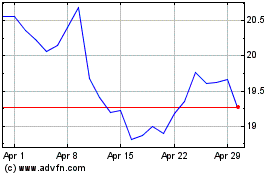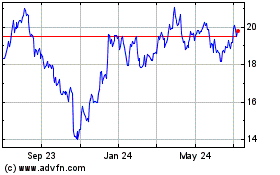CORRECT: Fed Completes Stress Tests Of 19 Largest US Banks
March 18 2011 - 11:55AM
Dow Jones News
The U.S. Federal Reserve said Friday it completed a new round of
tests on the financial health of the 19 largest U.S. banks,
clearing the way for some to immediately boost dividends to
shareholders.
The central bank did not disclose the results of the stress
tests and did not say which institutions were granted permission to
hike their dividends. The Fed said it would discuss the tests with
banks on Friday and would present them with a more detailed review
next month.
The move came after "significant improvement in both economic
conditions and the capital positions of financial institutions,"
the central bank said.
Analysts expect J.P. Morgan Chase & Co. (JPM) Wells Fargo
& Co. (WFC) and US Bancorp (USB) to soon announce modest
dividend increases. Citigroup Inc. (C) has already said it won't
reinstall its dividend until next year. Bank of America Corp. (BAC)
has said it requested the Fed allow a "modest" increase in its
dividend, but wasn't looking to boost the payment until the second
half of this year.
"The return of capital to shareholders under appropriate
conditions is a step in the process of improvement in the financial
sector and will help to promote banks' long-term access to
capital," the Fed said in a statement. "Such access will support
lending to consumers and businesses."
The Fed tested how banks would weather a worst-case economic
scenario where the inflation-adjusted gross domestic product, the
total value of goods and services produced in the economy,
contracts 1.5% this year. In addition, the Fed test envisioned the
unemployment rate would climb to 11% this year from the current
level of 8.9% and an index of U.S home prices would fall by
6.2%.
The Fed said banks are expected to limit their dividend payments
to 30% of their anticipated earnings for 2011. Any plans to buy
back shares or boost dividends will be reviewed by the Fed if a
bank's financial picture declines. If the economy takes an
unexpected turn for the worse, the Fed may force banks to change
their plans.
Not all 19 banks asked to boost their dividends, the Fed said.
It is unclear if the Fed objected to some banks' plans to raise the
dividend. It may have rejected banks dividend or share buybacks
plans because officials concluded the payment would weaken the
firm's ability to weather poor economic conditions, or because Fed
supervisors believed the banks had inadequate capital plans.
In February 2009, the Fed mandated that banks cut or eliminate
their dividends to shore up their financial position as the U.S.
economy reeled from the financial crisis of fall 2008. They were
barred from restoring those payments without the central bank's
permission.
The Fed has now conducted two rounds of special stress tests to
those banks, which have been deemed crucial to the health of the
financial system. The first round, in spring 2009, acted as a
public confidence-boosting exercise and allowed banks to repay
money they received from the Treasury Department's Troubled Asset
Relief Program.
Three big regional banks, KeyCorp (KEY), SunTrust Banks Inc.
(STI), Regions Financial Inc. (RF), still haven't repaid their TARP
funds, which they likely must do before boosting dividends.
-By Alan Zibel, Dow Jones Newswires; 202-862-9263;
alan.zibel@dowjones.com
Regions Financial (NYSE:RF)
Historical Stock Chart
From May 2024 to Jun 2024

Regions Financial (NYSE:RF)
Historical Stock Chart
From Jun 2023 to Jun 2024
